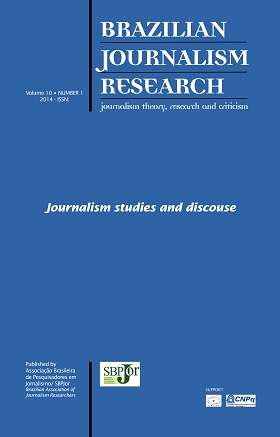Resumo
This paper aims to establish a discussion of the relationship between users x newspapers in cyberspace or, more specifically, in a Computer Mediated Communication Tool (CMC), the social networking site (SNS) Facebook. To establish the discussion proposed, this paper broke for exploration of interactions between users of Facebook and a newspaper of national expression, the Folha de São Paulo (FSP), through methodological procedures advocated by Grounded Theory (TF). Thus, there was the manual collection of a news report published by FSP on Facebook and of the 207 comments that followed. The analysis and systematization of data served to consolidate the intended debate and the social changes that shift the journalism position as the organizer legitimate of human experience.
Referências
BASTOS, M. T.; ZAGO, G. Visibilidade de notícias no Twitter e no facebook: Análise comparativa das notícias mais repercutidas na Europa e nas Américas. In: Brazilian Journalism Research. v. 9, n. 1. 2013. p. 116-133.
BOURDIEU, P. On Television. Nova York: The New Press, 1998.
BOYD, D.; ELLISON, N.. Social network sites: definition, history, and scholarship. In: Journal of Computer-Mediated Communication, 2007. Available at: <http://jcmc.indiana.edu/vol13/issue1/boyd.ellison.html>. Accessed on: 28 de setembro de 2010.
BRUNO, N. tweet first, verify later? How real-time information is changing the coverage of worldwide cirsis events. Oxford: Reuters Institute, 2011. p. 77. Available at: <https://reutersinstitute.politics.ox.ac.uk/fileadmin/documents/Publications/fellows__papers/2010-2011/TWEET_FIRST_VERIFY_ LATER.pdf>. Accessed on: 20 de maio de 2013.
BRUNS, A.; HIGHFIELD, T. Blogs, twitter, and Breaking News: The Produsage of Citizen Journalism. In: ANN LIND, R. (Org.). Produsing Theory in a Digital World: The Intersection of Audiences and Production. New York: Peter Lang, 2012. p. 15-32.
CÁDIMA, F. Das crises aos desafios do jornalismo na era pós-wikileaks. In.: CUNHA, I.; CABRERA, A.; SOUSA, J.P. (Org.). Pesquisa em media e jornalismo: homenagem a Nelson Traquina. Covilhã: Labcom, 2012. p. 234-253.
CASTELLS, M. A era da intercomunicação. Le Monde Diplomatique, Paris, 1º de agosto de 2006, Biblioteca Virtual, Outro Mundo. Available at:< http://www.diplomatique.org.br/acervo.php?id=1915>. Accessed on: 27 de abril de 2010.
CASTELLS, M. A sociedade em rede. São Paulo: Paz e terra, 2010.
DALMASO, S. Uma fanpage para compartilhar links: a utilização do Facebook pelo jornal Diário de Santa Maria. In: Simpósio nacional da ABCiber, 6., Novo Hamburgo. 2012. Anais... Novo Hamburgo, RS: ABCiber, 2012.
DAWKINS, R. O Gene Egoísta. São Paulo: Companhia das Letras, 2007.
DOMINGUES, I. Netizens e prosumers: novas mídias, co-criação e consumerismo político. In: #MídiasSociais: perspectivas, tendências e reflexões. Ebook Coletivo, 2010.
GLASER, B.; STRAUSS, A. L. The Discovery of Grounded Theory: Strategies for Qualitative Research. New York: Aldine de Gruyter, 1967.
GOMES, M. Jornalismo e ciências da linguagem. São Paulo: Hacker, 2000.
HERMIDA, A. Tweets and Truth: Journalism as a discipline of collaborative verification. Journalism Practice, v. 6, n. 5-6. 2012. p. 659-668.
JENKINS, H.; FORD, S.; GREEN, J. Spreadable Media. New York: NYU Press, 2013. p. 352.
JENKINS, H. Cultura da Convergência. São Paulo: Aleph, 2009.
JÚNIOR, F. Do papel ao Facebook: outras textualidades midiáticas no jornalismo da Folha de S. Paulo. Relêem, v. 6, n. 1. 2013.
LEMOS, A. Cibercultura. Porto Alegre: Sulina, 2004.
LEMOS, A. Ciber-cultura-remix. In: Seminário Sentidos e Processos. São Paulo: Itaú Cultural, 2005. Available at: http://tinyurl.com/2b5tjxy. Accessed on: 10 de janeiro de 2013.
LEMOS, A.; LÉVY, P. O futuro da internet: em direção a uma ciberdemocracia planetária. São Paulo: Paulus, 2010.
LÉVY, P. Cibercultura. São Paulo: 34, 1999.
O’BOYLE, L. The image of the journalist in France, Germany, and England, 1815-1848. In: Comparative Studies in Society and History. 1968. Available at: http://www.jstor.org/stable/177803. Accessed on: 13 de junho de 2010.
PENA, F. Jornalismo literário. São Paulo: Contexto, 2006.
PRIMO, A. Os Blogs Não São Diários Pessoais Online: Matriz Para Tipificação Da Blogosfera. Porto Alegre: Revista da Famecos, n. 36. 2008.
PRIMO, A. Transformações no jornalismo em rede: sobre pessoas comuns, jornalistas e organizações; blogs, Twitter, Facebook e Flipboard. Intexto. v. 2, n. 25. 2011. p.130-146.
RECUERO, R. A Conversação em Rede. Porto Alegre: Sulina, 2012.
RECUERO, R.; FRAGOSO, S.; AMARAL, A. Métodos de Pesquisa para Internet. Porto Alegre: Sulina, 2011.
RECUERO, R. Redes Sociais na Internet. Porto Alegre: Sulina, 2009a.
RECUERO, R. Redes Sociais na Internet, Difusão de Informação e Jornalismo: Elementos para discussão. In: SOSTER, D. de A.; FIRMINO, F. (Org.). Metamorfoses jornalísticas 2: a reconfiguração da forma. Santa Cruz do Sul: UNISC, 2009b. p. 1-269.
SCHUDSON, M. Porque as notícias são como são. In: Revista de Comunicação e Linguagens, v. 8, 1988.
SCHUDSON, M. The power of news. Cambridge: Harvard Press, 1995.
TEIXEIRA, M. O. A construção do enunciado jornalístico no Twitter. 229f. Dissertação (mestrado). Pelotas: Universidade Católica de Pelotas, 2011. Available at: http://antares.ucpel.tche.br/poslet/dissertacoes/Mestrado/2011/A%20Constru%E7%E3o%20do%20Enunciado%20Jornalistico%20no%20Twitter%20%20Mabel%20Oliveira%20Teixeira.pdf. Accessed on: 30 mar. 2014.
TEIXEIRA, M. O Jornalismo no Twitter: uma conversa transformadora?. In: XIII Congreso Internacional Ibercom. 13., Santiago de Compostela, 2013. Anais... Santiago de Compostela: IBERCOM, AssIBERCOM, AGACOM, 2013. p. 3945-3955.
TRAQUINA, N. Porque as notícias são como são. Florianópolis: Insular, 2005. (Teorias do jornalismo, v.1).
TRAQUINA, N. A tribo jornalística – uma comunidade interpretativa transnacional. Florianópolis: Insular, 2008. (Teorias do jornalismo, v. 2).
VIS, F. Twitter as a reporting tool for breaking news. Digital Journalism, v. 1, n. 1. 2012. p. 27-47.
Os direitos autorais dos artigos publicados nesta revista são de propriedade dos autores, com direitos de primeira publicação para o periódico. Em virtude da aparecerem nesta revista de acesso público, os artigos são de uso gratuito, com atribuições próprias, para fins educacionais e não-comerciais.
This work is licensed under a Creative Commons Attribution-NonCommercial-NoDerivatives 4.0 International License.


